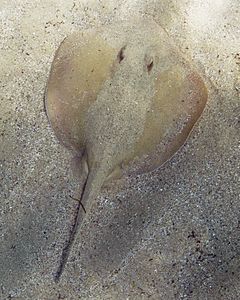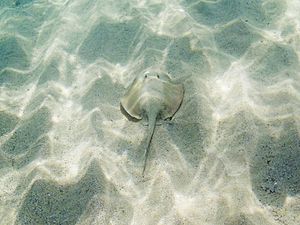Common stingaree facts for kids
Quick facts for kids Common stingaree |
|
|---|---|
 |
|
| Conservation status | |
| Scientific classification | |
| Kingdom: | |
| Phylum: | |
| Class: | |
| Subclass: | |
| Order: | |
| Family: |
Urolophidae
|
| Genus: |
Trygonoptera
|
| Species: |
T. testacea
|
| Binomial name | |
| Trygonoptera testacea J. P. Müller & Henle, 1841
|
|
| Synonyms | |
|
Trygonoptera australis Steindachner, 1866 |
|
The common stingaree (Trygonoptera testacea) is a type of stingray. It belongs to the family called Urolophidae. This ray is very common in the shallow waters off eastern Australia. You can usually find it in estuaries, sandy areas, and rocky reefs. It lives from the shore down to about 60 meters (200 feet) deep.
This stingaree has a rounded body, which is called a pectoral fin disc. Its snout is shaped like a triangle. It is usually brownish or grayish in color. Its nostrils have special flaps, and there's a fringed curtain of skin between them. The tail has a small dorsal fin just before its stinging spine. The end of its tail looks like a leaf. This ray can grow up to 52 centimeters (20 inches) long.
When they are young, common stingarees mostly eat shrimp. As they get older, they mainly eat polychaete worms. Female stingarees give birth to live young. The baby rays grow inside the mother, getting food from her. Females usually have two babies at a time. This stingaree is often caught by accident in commercial nets. It is also caught by people fishing for fun. Even though many are caught, their numbers seem stable. Because of this, the International Union for Conservation of Nature (IUCN) lists it as near threatened.
Contents
Discovering the Common Stingaree
The first time anyone recorded the common stingaree was through a drawing. An English naturalist named Joseph Banks drew it between 1768 and 1771. He saw a specimen from New Holland, which is now Australia.
Later, two German biologists, Johannes Müller and Jakob Henle, described the species. They used Banks' drawing for their work in 1839–41. They gave it the scientific name Trygonoptera testacea. The word testacea comes from Latin and means "brick-colored." In Australia, people sometimes just call this ray "stingray" or "stingaree."
Where it Lives and What it Likes
The common stingaree only lives in the coastal waters off eastern Australia. You can find it from Caloundra in southern Queensland down to Cape Howe in Victoria. Most of them live north of Jervis Bay. It is the most common ray in the shallow waters of this area.
This stingaree lives on the bottom of the ocean. It likes sandy areas and rocky reefs. It also swims into brackish estuaries, which are places where fresh water mixes with salt water. You can usually find it from the surf zone down to about 60 meters (200 feet) deep. Sometimes, it has been found deeper, up to 135 meters (443 feet) in soft-bottomed areas.
Appearance of the Common Stingaree
The common stingaree has a body that is wider than it is long. This body shape is called a pectoral fin disc. The front edges of its body are almost straight and meet at a wide angle to form its snout. The tip of its snout might stick out a little past its body.
Its eyes are medium-sized. Right behind the eyes are comma-shaped openings called spiracles. The outer edge of each nostril has a large, flat flap. Between its nostrils, there is a curtain of skin that looks like a skirt. This skin has a fringed edge and hangs over its small mouth. There are small, nipple-shaped bumps on its lower jaw and inside its mouth. Its teeth are small and have oval bases. It has five pairs of short gill slits.
The pelvic fins are small and rounded. The tail is almost as long as its body. It is flat and oval-shaped, without any folds on the sides. It has one or two stinging spines on its tail, about halfway along its length. Just before the sting, there is a small dorsal fin. In some stingarees, this fin might just be a small bump. The end of the tail has a long, leaf-shaped caudal fin. Its skin is completely smooth.
The common stingaree is usually plain brownish or grayish on top. It gets lighter towards the edges of its fins. The dorsal fin and the back edge of the caudal fin are darker. Young stingarees have completely black caudal fins. The underside of the stingaree is white. Sometimes, it has wide, dark bands along the sides of its body. This species can grow to about 52 centimeters (20 inches) long. Some records say they can be 61 centimeters (24 inches), but these might be other types of stingarees.
Life and Diet
The common stingaree lives in a similar way to the eastern shovelnose stingaree. That ray lives more to the south. More than three-quarters of the common stingaree's diet is made up of polychaete worms. It prefers worms that move around and are usually buried shallowly in the sand.
Another important food source is crustaceans. This includes shrimp, amphipods, penaeid prawns, crabs, isopods, and stomatopods. Sometimes, they also eat small bony fishes, lancelets, and molluscs. Very young stingarees, about 10–15 centimeters (4–6 inches) long, eat almost only shrimp. As they get older, worms become a much bigger part of their diet.
Reproduction and Life Cycle
Like other stingrays, the common stingaree gives birth to live young. The female stingaree feeds her embryos with a special, nutrient-rich liquid called "uterine milk." She usually gives birth to two babies at a time. They are probably born in early spring. The babies are about 12 centimeters (4.7 inches) long when they are born.
Male stingarees become old enough to reproduce when they are about 35 centimeters (14 inches) long. Females are ready when they are about 40 centimeters (16 inches) long.
This stingaree can have parasites. These include a type of tapeworm, a kind of fluke, and two types of nematodes.
Common Stingaree and People
A lot of fishing happens where the common stingaree lives. Many of these rays are caught by accident in large fishing nets. This happens with prawn trawlers off Queensland and New South Wales. They are also caught by other types of fishing, like estuary trawls and seine nets.
When caught by commercial fishers, these rays usually survive when they are thrown back into the water. However, some fishers might harm them. Also, stingarees often lose their babies when they are caught. People who fish for fun from the beach in Queensland and northern New South Wales also catch common stingarees. They sometimes leave them on the beach to die.
Even though many common stingarees are caught, their population is still strong. There is no sign that their numbers are going down. They seem to be less affected by changes to their habitat than other stingrays. They are even found in large numbers near cities like Sydney. Because of this, the International Union for Conservation of Nature (IUCN) has listed this species as near threatened. This means it might become endangered in the future, but it is not yet.
The common stingaree lives in several marine protected areas. These are special places in the ocean where animals are protected. It could also benefit from a plan made in 2004 to help protect sharks and rays in Australia.



